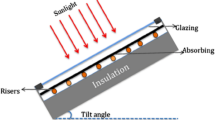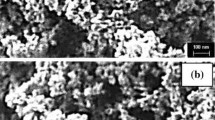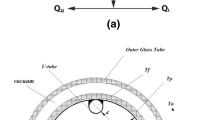Abstract
This study looks at the effects of different kinds of nanoparticles including AL2O3, SiO2, and CuO on the design of a solar flat plate collector in different volumetric concentrations. Water was used as the base fluid, and optimal SFPC parameters were obtained for each of the nanofluids. Both the efficiency and total annual cost were selected as objective functions, and the optimum Pareto fronts were compared with those of the base fluid. The results show a significant enhancement in both the efficiency and TAC for all the studied nanofluids compared with the pure water as the working fluid. The efficiency improved by 4.47%, 4.65%, and 5.22% in the cases of AL2O3, SiO2, and CuO compared with base fluid with a fixed TAC of 67 $ year−1. With a fixed efficiency of 0.564, TAC decreased by 25.45%, 25.87%, and 27.88%, respectively. The optimum design parameters show that lower heat transfer surface area and insulator thickness are needed for CuO compared with the other cases, followed by SiO2, AL2O3, and the base fluid. In the optimum conditions, a lower particle volumetric concentration is required for CuO, followed by Al2O3 and SiO2.






Similar content being viewed by others
Abbreviations
- a:
-
Annual parameter (–)
- A:
-
Surface area (m2)
- C :
-
Cost ($)
- c p :
-
Heat capacity (J kg−1 K−1)
- \(C_{\text{op}}\) :
-
Operational cost ($ year−1)
- C p :
-
Heat capacity (kJ kg−1 K−1)
- D :
-
Diameter (m)
- F :
-
Friction factor (–)
- F R :
-
Heat removal factor (–)
- h :
-
Convection heat transfer coefficient (W m−2 K−1)
- i :
-
Interest rate (–), point index (–)
- I :
-
Radiation (W m−2)
- j :
-
Objective index (–)
- K :
-
Conductivity (W m−1 K−1)
- k el :
-
Electricity cost ($ kWh−1)
- knp :
-
Unit price of nanoparticle ($ kg−1)
- L :
-
Collector length (m)
- \(\dot{m}\) :
-
Mass flow rate (kg s−1)
- m np :
-
Nanoparticle mass (kg)
- N :
-
Number of tubes (–)
- n :
-
Number of points (–)
- N h :
-
Operational hours (hour year−1)
- N p :
-
Number of plate (–)
- Nu :
-
Nusselt number (–)
- Pr :
-
Prandtl number
- \(\dot{Q}\) :
-
Heat rate (W)
- Ra :
-
Rayleigh number (–)
- R b :
-
Total ratio of radiation
- Re :
-
Reynolds number (–)
- S :
-
Absorbed radiation (W m−2)
- U :
-
Collector loss coefficient (W m−2 K−1)
- V :
-
Collector volume, velocity
- W :
-
Space between tubes (m)
- \(\dot{W}_{\text{p}}\) :
-
Pump power (kW)
- y :
-
Lifetime (year)
- β :
-
Collector angle (°)
- δ :
-
Thickness (m)
- \(\Delta P\) :
-
Pressure drop
- ε :
-
Emission (–)
- η :
-
Efficiency (–)
- φ :
-
Assembly parameter (–)
- μ :
-
Viscosity (Pa s)
- ∀ insu :
-
Insulation volume (m3)
- \(\rho_{\text{g}}\) :
-
Ambient reflectance (–)
- σ :
-
Boltzmann constant
- ϕ :
-
Volume concentration
- a:
-
Ambient
- b:
-
Bottom
- b:
-
Belt
- bf:
-
Base fluid
- c:
-
Cover
- col:
-
Collector
- e:
-
Edge
- eff:
-
Effective
- i:
-
Inner
- insu:
-
Insulation
- inv:
-
Investment
- nf:
-
Nanofluid
- np:
-
Nanoparticle
- o:
-
Outer
- p:
-
Plate, pump
- t:
-
Tube, top
- HE:
-
Heat exchanger
- NSGA:
-
Non-sorting genetic algorithm
- PVC:
-
Particle volume concentration
- SFPC:
-
Solar flat plate collector
- STHE:
-
Shell-and-tube HE
- TAC:
-
Total annual cost ($ y−1)
References
Loni R, Kasaeian AB, Mahian O, Sahin AZ. Thermodynamic analysis of an organic rankine cycle using a tubular solar cavity receiver. Energy Convers Manag. 2016;127:494–503.
Bellos Evangelos, Tzivanidis Christos, Papadopoulos Angelos. Enhancing the performance of a linear Fresnel reflector using nanofluids and internal finned absorber. J Therm Anal Calorim. 2019;135(1):237–55.
Tiwari AK. Application of nanoparticles in solar collectors: a review. Mater Today Proc. 2015;2:3638–47.
Kiliç F, Menlik T, Sözen A. Effect of titanium dioxide/water nanofluid use on thermal performance of the flat plate solar collector. Sol Energy. 2018;164:101–8.
Hajabdollahi F, Premnath K. Numerical study of the effect of nanoparticles on thermoeconomic improvement of a solar flat plate collector. Appl Therm Eng. 2017;127:390–401.
Hawwash AA, Rahman AKA, Nada SA, Ookawara S. Numerical investigation and experimental verification of performance enhancement of flat plate solar collector using nanofluids. Appl Therm Eng. 2018;130:363–74.
Mirzaei M, Hosseini SMS, Kashkooli AMM. Assessment of Al2O3 nanoparticles for the optimal operation of the flat plate solar collector. Appl Therm Eng. 2018;134:68–77.
Siavashi M, Ghasemi K, Yousofvand R, Derakhshan S. Computational analysis of SWCNH nanofluid-based direct absorption solar collector with a metal sheet. Sol Energy. 2018;170:252–62.
Aberoumand S, Ghamari S, Shabani B. Energy and exergy analysis of a photovoltaic thermal (PV/T) system using nanofluids: an experimental study. Sol Energy. 2018;165:167–77.
Hassan MM, Teamah MA, El-Maghlany WM. Numerical investigation for heat transfer enhancement using nanofluids over ribbed confined one-end closed flat-plate. Alex Eng J. 2017;56:333–43.
Yurddas A, Çerç Y. Numerical analysis of heat transfer in a flat-plate solar collector with nanofluids. Heat Transf Res. 2017;48:8–16.
Ahmadi F, Abedini-Saniji MH, Yaghoubi MA, Goshtasbirad E. Three-dimensional Numerical study of AL2O3-terminal VP-1 nanofluid on heat transfer enhancement from an absorber tube of a parabolic trough collector. In: ICHMT digital library online. 2014. http://www.dl.begellhouse.com/references/1bb331655c289a0a,63ad07a47887553a,7ceedac765d92363.html?year=2017.
Jouybari HJ, Saedodin S, Zamzamian A, Nimvari ME, Wongwises S. Effects of porous material and nanoparticles on the thermal performance of a flat plate solar collector: an experimental study. Renew Energy. 2017;114:1407–18.
Jouybari HJ, Nimvari ME, Saedodin S. Thermal performance evaluation of a nanofluid-based flat-plate solar collector. J Therm Anal Calorim. 2019;1–18.
Hajabdollahi H, Hajabdollahi Z. Assessment of nanoparticles in thermoeconomic improvement of shell and tube heat exchanger. Appl Therm Eng. 2016;106:827–37.
Hajabdollahi H, Hajabdollahi Z. Numerical study on impact behavior of nanoparticle shapes on the performance improvement of shell and tube heat exchanger. Chem Eng Res. 2017;125:449–60.
Said Z, Saidur R, Rahim NA. Energy and exergy analysis of a flat plate solar collector using different sizes of aluminium oxide based nanofluid. J Clean Prod. 2016;133:518–30.
Hajabdollahi H, Hajabdollahi Z. Investigating the effect of nanoparticle on thermo-economic optimization of fin and tube heat exchanger. Proc Inst Mech Eng Part E J Process Mech Eng. 2017;231:1127–40.
Bellos Evangelos, Tzivanidis Christos. A review of concentrating solar thermal collectors with and without nanofluids. J Therm Anal Calorim. 2019;135(1):763–86.
Sabiha MA, Saidur R, Hassani S, Said Z, Mekhilef S. Energy performance of an evacuated tube solar collector using single walled carbon nanotubes nanofluids. Energy Convers Manag. 2015;105:1377–88.
Bellos Evangelos, Tzivanidis Christos. Thermal efficiency enhancement of nanofluid-based parabolic trough collectors. J Therm Anal Calorim. 2019;135(1):597–608.
The MathWorks Inc. MATLAB and Statistics Toolbox Release 2014b. Natick: The MathWorks Inc; 2014.
Hay JE, Davies JA. Calculation of the solar radiation on an inclined surface. In: Proceedings of the first canadian solar radiation data workshop, 1980. p. 59.
Duffy J, Beckman W. Solar engineering of thermal processes. New York: Wiley; 1991.
Sharma KV, Sarma PK, Azmi WH, Mamat R, Kadirgama K. Correlations to predict friction and forced convection heat transfer coefficients of water based nanofluids for turbulent flow in a tube. Int J Microsc Nanoscale Therm. 2012;3:1–25.
Vajjha Ravikanth S, Das Debendra K, Kulkarni Devdatta P. Development of new correlations for convective heat transfer and friction factor in turbulent regime for nanofluids. Int J Heat Mass Transf. 2010;53(21–22):4607–18.
Mitchell JW. Heat transfer from spheres and other animal forms. Biophys J. 1976;16:561–9.
Fabio S. Analysis of a flat-plate solar collector. MVK160 Heat and Mass Transport. 2008.
Mitchell JW. Heat transfer from spheres and other animal forms. Biophys J. 1976;16:561–9.
Hollands KGT, Unny TE, Raithby GD, Konicek L. Free convective heat transfer across inclined air layers. J Heat Transf. 1976;98:189–93.
Hajabdollahi Zahra, Hajabdollahi Hassan. Thermo-economic modeling and multi-objective optimization of solar water heater using flat plate collectors. Sol Energy. 2017;155:191–202.
Hajabdollahi F, Premnath K. Numerical study of the effect of nanoparticles on thermoeconomic improvement of a solar flat plate collector. Appl Therm Eng. 2017;127:390–401.
Sanaye S, Hajabdollahi H. 4 E analysis and multi-objective optimization of CCHP using MOPSOA. Proc Inst Mech Eng Part E J Process Mech Eng. 2014;228:43–60.
Acknowledgements
This research was supported by the International Research and Development Program of the National Research Foundation of Korea (NRF), which is funded by the Ministry of Science and ICT of Korea (NRF-2017K1A3A1A30084513). Partial support was also obtained from the National Research Foundation of Korea (NRF) grant, which is funded by the Korean government (MSIT) (Nos. 2011-0030013 and 2018R1A2B2007117).
Author information
Authors and Affiliations
Corresponding author
Additional information
Publisher's Note
Springer Nature remains neutral with regard to jurisdictional claims in published maps and institutional affiliations.
Rights and permissions
About this article
Cite this article
Hajabdollahi, Z., Hajabdollahi, H. & Kim, K.C. Multi-objective optimization of solar collector using water-based nanofluids with different types of nanoparticles. J Therm Anal Calorim 140, 991–1002 (2020). https://doi.org/10.1007/s10973-019-08444-w
Received:
Accepted:
Published:
Issue Date:
DOI: https://doi.org/10.1007/s10973-019-08444-w




